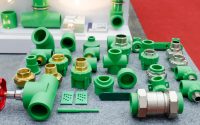Adding a Portable Fire Pump to a Water-Based Fire Suppression System
Fire pumps are pressure-increasing components in water-based fire suppression systems. They are integrated into fire trucks and fire boats, and also operate as standalone devices to boost the water supply for firefighting hose operations.
Fire fighting pumps are needed when it is determined that the existing water supply cannot meet the fire sprinkler system’s hydraulic design requirements. This usually happens in high-rise buildings or expansive spaces like warehouses.
Boosts Water Flow
When firefighters are fighting a fire, they require a high volume of water at a pressure sufficient to move the water through hoses and appliances and extinguish the fire. Typically, the fire sprinkler system is connected to the municipal water supply through a fire department connection (FDC). Fire pumps are used in some installations to supplement this demand, especially when there is insufficient pressure in the city water distribution pipes to operate the sprinkler system or if the FDC is located upstream of the pump.
NFPA 20 specifies that fire pumps be sized based on the most hydraulically demanding area of the building. For example, an automatic fire standpipe system may require 500 gallons per minute at 100 pounds per square inch in the highest demand area of the building. A fire pump is sized to achieve this flow with an acceptable safety factor. The maximum net pressure that the fire pump can produce varies along its performance curve, with a higher pressure at churn and a lower one at rated flow.
Fire pumps have to be able to produce this pressure and the associated volume, while also meeting world wide standards governing exhaust emissions and noise levels. Advances in air-cooled engines and materials have made portable fire pumps a reliable tool for modern firefighters. Similarly, industrial internet of things (IoT) remote monitoring solutions are changing how much information fire protection managers can get from their fire pump systems, leading to safer and more informed systems.
Boosts Pressure
In order to operate, a fire pump must have enough pressure to produce an adequate water flow and deliver it with sufficient velocity to suppress a fire. Most municipal water supplies have enough pressure to do this, but in some cases a fire pump is necessary. In these instances, the building does not have enough gravity-based water pressure to support the sprinklers or other fire suppression systems.
Fire pumps typically have electric or diesel engines to power them. They also require a backup generator to be used in the event of a power failure. These generators must be UL Listed or FM Approved and have a 460 volt, three-phase electrical motor. Diesel fire pumps are often more expensive than their electric counterparts, but they have more mechanical parts that can be prone to failure.
When selecting a fire pump, it is important to consider the rated net pressure of each model. This information can be found on the manufacturer’s performance curve for that model. To calculate this, start by finding the suction pressure at churn (no flow) and then add the system demand flow. This will give you the discharge pressure that is expected at the nozzle. Then, determine if this pressure is lower than or equal to the rated pressure for the downstream fire protection components.
Boosts Flow Rate
Adding a fire pump to an existing sprinkler or standpipe system can increase water flow without increasing the pressure. A fire pump is sized to meet the hydraulic demand of the most demanding area of a building’s sprinklers, standpipes or mist systems. This is typically determined by a water flow test that has been conducted within the past year.
The fire pump size must be determined before installing any piping, nozzles or valves. The test must be performed at a location where flowing water won’t cause damage. T-shaped hose monsters that counteract the force of the flowing water can be used instead of hose nozzles to make it safer for firefighters to hold the hoses during testing. In addition, the hoses should be carefully positioned and secured. During the flow test, firefighters must be able to read the gauges accurately and the equipment used for measuring pressure and water flow should be calibrated to meet specific requirements.
Portable fire pumps use an electric motor or diesel engine for power. Angus Fire offers petrol-powered portable fire fighting pumps for general purpose applications and diesel-powered models for wide open spaces like farms, warehouses, refineries, marine vessels and drilling rigs. Regardless of which model is used, all fire fighting pumps must operate with an uninterrupted power source and have an emergency generator that can be connected to the fire pump controller.



